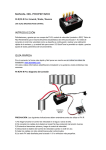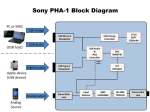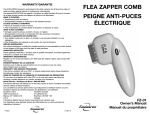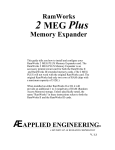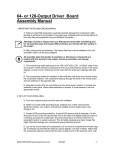Transcript
battery even reaches the end-user and cannot be remedied. Conversely, crystal growth occurs over time and can be rectified. As a cell self-discharges it becomes more susceptible to high-resistance shorts, a phenomenon in which crystal growth is so extensive that the separator is bridged by conductive material. The Battery Nurse monitors the State of Charge (SOC) and attends to the cells to help minimize the formation of crystals. Any high-resistance short that attempts to develop is summarily zapped; blown like a fuse. Battery Nurse VCS Congratulations and thank you for purchasing Tekin’s Battery Nurse VCS! Unlike any other battery care product ever made, the Battery Nurse uses a proprietary Voltage Control System (VCS) to automatically and safely maintain the peak performance characteristics of new battery packs. The Battery Nurse was carefully designed to be simultaneously a very powerful addition to your pit, yet easy to integrate into your current battery care and maintenance program. User Manual Getting Started: Batteries are perishable and will eventually fail despite all efforts to prevent them from doing so; The Battery Nurse is a proactive weapon designed to minimize the effects of battery aging. Battery care and conditioning is somewhat of a dark art and most conventional approaches still rely on the time-tested methodology of battery conditioning through cycling and discharge, even while batteries have changed significantly. It is important to understand that all batteries exhibit a certain amount of self-discharge; the tendency is most pronounced, however, in nickel-based batteries. NiMh batteries tend to selfdischarge at 3-4% of capacity per day, NiCd batteries selfdischarge at a rate of about 1% per day. The self-discharge rate is highest for the first 24 hours after being charged and continues at a rate of about 10-15% in the following week, dropping to 1015% per month thereafter. Just what defines a loss of battery performance can be described in several ways, physical failure, loss of capacity, and loss of power. The Battery Nurse works by addressing each of these failure mechanisms. Physical component failure in NiCd and NiMh batteries typically involves the separator between the conductive plates. Separator failure can happen in a number of ways, the principal causes are dry-out due to loss of water in the cell and by crystal growth. Abusive overcharge and over-discharge conditions can contribute to water loss in the cell and cause the separator to dry out; these conditions can be inflicted during the matching process before the Loss of capacity and loss of power both occur for the same reasons, to some extent the cause is again the failure of the separator but a secondary cause has been found to be the degradation of active material on the electrodes. Degradation occurs in the form of corrosion, and research indicates that corrosion formation is intensified through the charge and discharge cycle. The Battery Nurse uses the VCS system to prevent unwanted discharge, i.e. self-discharge, and in doing so eliminates the formation of corrosion that is not a direct result of active use of the battery. Just as significantly, the Battery Nurse VCS also avoids any unnecessary charging, which can also contribute to corrosion formation. Batteries that are stored on the Battery Nurse between uses will not require any potentially damaging cycling, which was previously necessary to achieve peak performance levels. This should be noticeable immediately in newer packs; they can be taken directly from the Battery Nurse, discharged, peaked on a charger, and will still deliver good punch. Simply put, the Battery Nurse helps delay the inevitable, it keeps good batteries good longer, helps keep batteries that want to go bad from going bad as quickly, and does absolutely nothing for bad batteries that are already bad (if only it could…). SPECIFICATIONS Battery Types Voltage Hold Levels Hold Voltage Supply (Auto-Switch Primary/Secondary) Pack Connection Wires/Connectors Dimensions Sub C or 2/3A NiMh and NiCd 4 Cell: 5.2V, 5.4V 5 Cell: 6.5V, 6.7V 6 Cell: 7.8V, 8.0V Primary: 120VAC to 12VDC Adapter (included) Secondary: 9VDC Battery 1-6 Packs (Cell Count Must Match) 20 Gauge Wire , 6 Pairs / Alligator Clips, 6 Pairs 3” x 5” x 1” (76mm x 127mm x 25mm) Connection and General Operation: Alligator clips are provided as an optional convenience method for connecting the Battery Nurse to your packs, if you prefer this method you will first need to solder the clips on to the wires. Note that direct soldering the wires to the packs is more effective and safest, but in either case take care that unused wires DO NOT come in contact with exposed battery pack terminals—tuck them into any empty slots when not in use. Hint: When placing packs in the case, arrange them so that all positive terminals are at the same end of the case (toward the handle is best) to minimize the chance of two packs shorting together. The Battery Nurse will perform most functions automatically with minimal user intervention, however, proper treatment of the battery prior to connecting to the Battery Nurse is critical to obtain the best results. The Battery Nurse is powered On/Off by pressing and holding the power button for 3 seconds, the same button is then pressed and released to select the desired Voltage Hold Level. The Battery Nurse has a bank of PACK STATUS LEDs that are numbered to correspond to each set of wires. A second set of VOLTAGE HOLD LEDs indicate which Voltage Hold Level is currently in use. The standby power mode (9V battery) will not be able to meet the needs of multiple packs for an extended period of time and should only be used when no other source of power is available. A flashing Voltage Hold LED indicates a power supply level that is too low for correct operation. Proper Battery Preparation and Care: 1. At the end of a run, discharge the pack with a discharger. A 10A or less discharge is recommended to minimize the risk of cell reversal and electrolyte loss, although discharge levels as high as 35A may be used with some packs. 2. Use an equalizing tray to bring the cells to the same approximate state of charge. The tray should have a cutoff that will not allow each cell to drop below a specific voltage, 0.5 to 1.0 volts. 3. Charge the pack to 30-50% of full capacity—for example, with a 4200 mAh pack, 30% would be 4200 x 30% = 1260mAh. By setting your charger at 5 Amps and charging for 15 minutes, you would be putting in 1250 mAh, slightly less than a 30% charge. 4. Connect the battery pack to the Battery Nurse with alligator clips or by soldering the wires to the pack + and - battery terminals. 5. Press and hold the power button for 3 seconds to turn on the Battery Nurse, then select the desired Voltage Hold. Use the lower Voltage Hold setting and if after 36 hours a pack demonstrates minimal need for Voltage Hold you may try the higher setting. 6. For each battery pack connected, the corresponding PACK STATUS LED will flash occasionally as the Nurse performs a status check on that battery. If a battery has self-discharged down to the selected VOLTAGE HOLD, a signal is applied to address the various possible failure mechanisms. A good initial indication that the battery has been damaged is a continuously lit PACK STATUS LED immediately after connection. Allow the battery to remain connected and monitor it over the next few days to determine if the pack condition stabilizes. 7. For best results, batteries should remain connected to the Battery Nurse whenever they are not being actively charged, conditioned, or used. Use the primary power supply whenever possible. Identifying Good/Bad Batteries: Good batteries are indicated by little need for maintenance for up to 36 hours after first connecting, after which the pack will periodically move in and out of Voltage Hold. The Battery Nurse operates automatically and no user intervention is necessary with a good pack, however, a bad cell in an otherwise good pack can affect the results. A cell in the process of going bad will typically be indicated by a continuously lit LED as the Battery Nurse attempts to correct the pack’s condition. When a battery exhibits these signs use a digital multimeter to check each cell’s voltage and write the results down. Cycle the battery with a discharger, equalize on a tray, then recharge to 3050% of capacity. Reconnect to the Battery Nurse for 36 hours. If the pack continues to require constant attention a cell may have become damaged beyond repair. Any damaged cells should be removed from the pack and replaced with known good cells so that any potential failure conditions in the pack’s other cells can be effectively corrected. Limited Warranty: TEKIN, INC. guarantees all products to be free from factory defects in materials and workmanship for a period of 120 days from date of purchase, when verified by sales receipt. This warranty does not cover: suitability for specific application, components worn by use, application of reverse or improper voltage, tampering, misuse, or shipping. Our warranty liability shall be limited to repairing unit to our original specifications. Because we have no control over the installation or use of this product, in no case shall we be liable for damages. Additionally, these items void the warranty: 1. Using any other type of battery not made for the Battery Nurse. 2. Allowing water or moisture into the unit. 3. Use inconsistent with the instructions. For warranty work, you MUST CLAIM WARRANTY on PRODUCT SERVICE FORM & include a valid cash register receipt with purchase date and dealer name & phone number on it, or an invoice from previous service. If warranty provisions have been voided, there will be service charges. NOTE: Hobby dealers or distributors are not authorized to replace products thought to be defective. For Service Requests/Tech Support Check our website or contact our customer service dept. by phone. Tekin, Inc. (208) 634-5559 634-5569 (FAX) www.teamtekin.com
